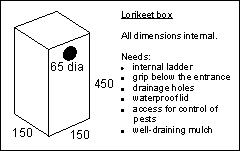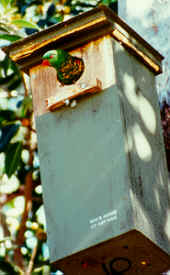Product range:
Batboxes
Pale-headed rosella
Eastern rosella
Cockatiel
Rainbow lorikeet
Scaly-breasted lorikeet
Galah
Kookaburra
Dollar bird
Boobook owl
Brushtail possum
Brushtail vertical
Ringtail possum
Squirrel glider
Sugar glider
| Scaly-breasted lorikeet nestbox |
|
|
| Home / Contact us / Product range / Stories / Pest management / Prices |
| We use only a single box for
lorikeets, and that design has had wide success with rainbows. While the same design has
been used by scaly-breasted lorikeets, the numbers involved have been much smaller. The scaly is a smaller bird and would probably use a smaller box with a smaller entrance. On the other hand, we have had scaly's use several of the larger rosella boxes, so size does not seem to be of great importance. While the numbers of scaly's using boxes is much less than the number of rainbows, usage is probably proportional to the relative size of the populations of the two birds in south-east Queensland.
|
|
| Apparently the
scaly was originally much more prolific than it is now, and the decline in their numbers
has been matched by an increase in the numbers of rainbow lorikeets. The scaly is
predominately a bird of the rural landscape with a fairly specialised diet, and it is
likely that the decline is due more to a change in land use than a shortage of hollows. Reference: Christine Cannon (1984) "The diet of lorikeets Trichoglossus ssp in the Queensland-New South Wales border region", Emu 84, 16-22.
|
|
| The sketch shows the dimensions which we have found most suitable for rainbow lorikeets, and which seems to work well with scaly-breasted lorikeets. Larger dimensions have also been found to be satisfactory. | 
|
| Click here for information on prices. | |

